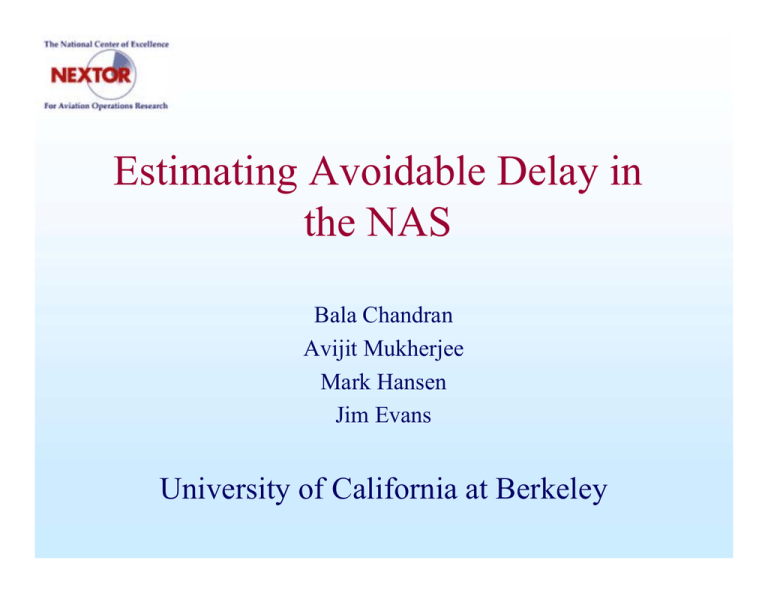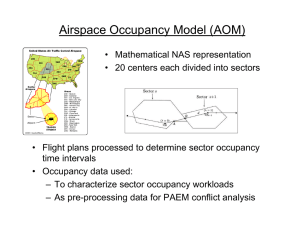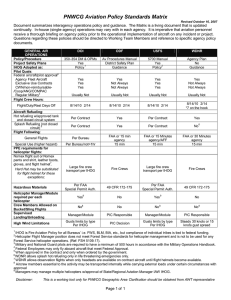Estimating Avoidable Delay in the NAS University of California at Berkeley Bala Chandran
advertisement

Estimating Avoidable Delay in the NAS Bala Chandran Avijit Mukherjee Mark Hansen Jim Evans University of California at Berkeley Outline • • • • Motivation The Bertsimas-Stock model for TFMP. A case study: Aug 24, 2002. Benefits assessment of CIWS echo tops product. • Conclusions and contributions. Jan 28, 2004 2 Motivation • Given schedule, optimize airspace (sector, airport) usage through effective holding/routing strategies (Bertsimas et. al., 1995) in response to time-varying capacity. • Could be viewed as a – – – – – Decision support tool. Performance evaluation/ benchmarking tool. Benefits assessment tool. Network design system. Pricing support mechanism. Jan 28, 2004 3 Model Description (Data) • Schedule (OAG) and filed flight plan. • Time each aircraft spends in a sector (detailed 3-d trajectory model). • Airport departure and arrival rates . • Sector capacity (or a penalty function?). • Flight connectivity and turnaround time. • Cost of delay/cancellation. Jan 28, 2004 4 Model Description (Objective) • Minimize – – – – – – Jan 28, 2004 Total delay of all aircraft. Weighted sum of ground and airborne delay. Total gate-to-gate time. Total passenger delay. Sector overage. Total system cost. 5 Model Description (Constraints) • • • • • Sector capacity (hard/soft). Airport capacity (hard/soft). Flight connectivity. Min. and max. time of each aircraft in a sector. Max total delay per aircraft (cancellation). Jan 28, 2004 6 Case Study : Aug 24, 2002 Data Sources • Individual flights data: FAA - ASPM. • Trajectory information: MIT - Lincoln Lab ETMS Radar Tracks. • Preferred routes: FAA - CDR. • Nominal sector capacity: FAA, NASA Ames. • Weather coverage: MIT - Lincoln Lab CCFP CIWS. Jan 28, 2004 7 Case Study : Aug 24, 2002 Figure 1. Severe weather over N-E United States Jan 28, 2004 8 Assumptions (Airports) Figure 2. Subset of origin-destination pairs considered. Jan 28, 2004 9 Assumptions (Flights) • 2422 flights considered between major airports. • Time: 1800-2400 Z. • Flight plans chosen from Coded Departure Routes (CDR). • Long-range flights considered separately and given priority. Jan 28, 2004 10 Assumptions (Trajectory) h α Origin β Destination Parameters were estimated from trajectory data on a goodweather day. Parameters were assumed to be dependent on aircraft type and trip distance. Jan 28, 2004 11 Assumptions (Capacity) Capacity Linear capacity tradeoff function K < 100 % weather coverage Jan 28, 2004 12 Results (shortest route only) Metric Actual Model Airborne time (Minutes) 194,000 (197,000 filed) 176,400 0.62 min (-7.07 min on Aug 7) 4.4 min (3.6 min without connectivity) Delay/flight Interesting: The model assigned NO airborne delay. Jan 28, 2004 13 Additional Routes Figure 3. Added routes shown in black. Jan 28, 2004 14 Results (multiple routes) Metric Model (single route) Model (multiple routes) Airborne time (Minutes) 176,400 177,900 Delay/flight 4.4 min (3.6 min without connectivity) 2.7 min (2.1 min without connectivity) “Delay” for multiple routes is with respect to the flight time on the shortest path for that flight. Again, there was NO airborne holding. Jan 28, 2004 15 Benefits Assessment of Echo-Tops Aircraft appear to be using “blocked” sectors! Jan 28, 2004 16 CIWS Echo-Tops Product NEXRAD ECHO-TOPS Jan 28, 2004 17 Results (Echo-Tops Single Route) Metric Model (single route) Model echo tops (single route) Airborne time (Minutes) 176,400 176,400 Delay/flight 4.4 min (3.6 min without connectivity) 1.8 min (1.1 min without connectivity) High and super high sectors were virtually unaffected. Jan 28, 2004 18 Conclusions (1) • It is now possible to answer several questions regarding the performance of the NAS on August 24th. – Decision support: What routes/delays should be assigned to flights to optimize operations (depending on metric)? – Benchmarking: How far were the operations from optimal (depending on metric)? – Schedule Evaluation: Is the given schedule feasible with full capacity? Jan 28, 2004 19 Conclusions (2) • Some more questions. – Benefits assessment: What are the benefits of providing echo-tops information to identify situations where aircraft can safely fly over storms? How much would you be willing to invest in it? – Network design: How would building an additional runway impact the traffic flows in the NAS? – Pricing mechanisms: What is the contribution of each aircraft to the total system cost? [Dual prices of LP give marginal utility of each additional unit of resource capacity and marginal cost of each aircraft to the system.] Jan 28, 2004 20 Contributions of Study • First application of the Bertsimas-Stock model to a large-scale real-world scenario. • Cancellations explicitly modeled. • Problem studied in three dimensions. • Uses other than decision support were motivated. Jan 28, 2004 21





